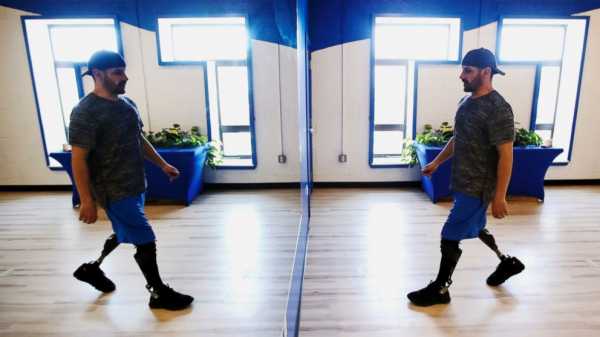
In the five years since the Boston marathon bombing, medical science has made promising advances in the field of amputation and prosthetics, partially because of lessons learned from victims and research dollars as a result of the attack.
Some of the 17 people who lost limbs on April 15, 2013, bombing could, like many other disabled people, benefit from these developments, as many are at crossroads in their treatment. A number of are still struggling with the pain while others try to replace their prostheses, which are approaching the end of their useful life.
“The collective experience in the aftermath of the Boston marathon bombing was very positive in the medical community, because there was a lot of crosstalk between military and civilian surgeons,” said Dr. Benjamin Potter, chief orthopedic surgeon at Walter reed national military medical center in Maryland, where three survivors were treated and the doctors are trying some of the advanced procedures.
“This exchange and the dialogue was one of the silver linings to come out of this, what we hope, better educated and better prepared for the next one.”
Among other places where research is being conducted airport in Boston, where doctors are working to combine an improved method of amputation with more complex artificial limbs so that patients can one day use their brains to control their prostheses.
The project grew out of lessons Boston doctors treating victims of the marathon attack. It became possible thanks to $200,000 in seed funding from the Gillian Reny stepping strong Center of traumatology innovation , the Foundation launched the family survived the explosion at the hospital Brigham and women’s.
“One of the things, explosions crystallized for me was the need to improve amputations,” said Dr. Matthew Carty, Brigham and women’s surgeon who develops a new technique of amputation. “We have made amazing advances in prosthetic technologies — indeed, by leaps and bounds — but how do we do the amputation are not aware of the opportunities that exist now.”
A new lower leg amputation method, which until now was done by seven people, keeps tendons usually lost during amputation. Tendons connect muscle to bone and is required to move a single limb.
It is hoped that researchers from mit can then develop a technology that will translate brain signals into movement of an artificial leg. Patients may be able to perceive sensations through their prosthetic devices.
“We systematically rebuild the body together with synthetics to maximize the connection between body and machine,” said Hugh Herr, co-Director of the Center for extreme Bionics at mit and partner Carty on the project. “It’s very interesting.”
And the fruits of this work may be years in the future, the survivors of the marathon may also benefit from other developments.
One procedure involves direct connection of prostheses to bone with titanium implants. These bone-anchored prostheses have been placed on hundreds of patients in other countries, but it was not until 2015 that the use of the devices was allowed in the U.S.
About 50 such operations had been done in this country, including 16 at Walter reed, according to Potter.
Brigham and women, also among U.S. hospitals seeking to make the country’s first successful transplant of legs . Surgical feat was accomplished in only a few countries, including Spain and Canada.
Bombing survivor Marc Fucarile, who was the last to be released from the hospital, he said he was intrigued by new developments, even if it is not in a hurry to again go under the knife soon.
This 39-year-old from Boston lost his right leg in the explosion and his badly crippled left leg causes him ongoing pain. He fears another amputation may be his only option.
Artificial limbs that Fucarile and other survivors were provided usually last five to seven years, so patients should determine the correct technology for the next phase of his life.
“Sometimes, top-of-the-line Porsche not always practical,” said Paolo Bonato, who oversees research on prosthetics at Spaulding Rehabilitation hospital in Boston, where many of the victims were treated. “It may be more reasonable to have a Honda”.
Rarely saw five years ago, civilians, prostheses used by many survivors of microprocessors and sensors which automatically adjust the limbs and allows for more natural movement. Now they are more common, but they can cost about $15,000 to more than $100,000, said Dr. David Spalding Guests.
For some patients, insurance is often not sufficient to cover the costs. Boston victims, however, received payments from the compensation Fund, and some have made efforts to raise funds or find other ways to cover their expensive devices.
Fucarile, whose carbon-fiber and titanium leg was originally designed to help wounded soldiers return to battle, said that his prosthesis is not a luxury.
“If you are an insurance company, look at the long-term effect that you’re saving”, – he said. “If I don’t have my prosthesis, I’d probably overweight, heart disease, to be closer to the diabetes and probably more depressed.”
—
Follow Philip Marcelo in https://twitter.com/philmarcelo . His work can be found here .
Sourse: abcnews.go.com






